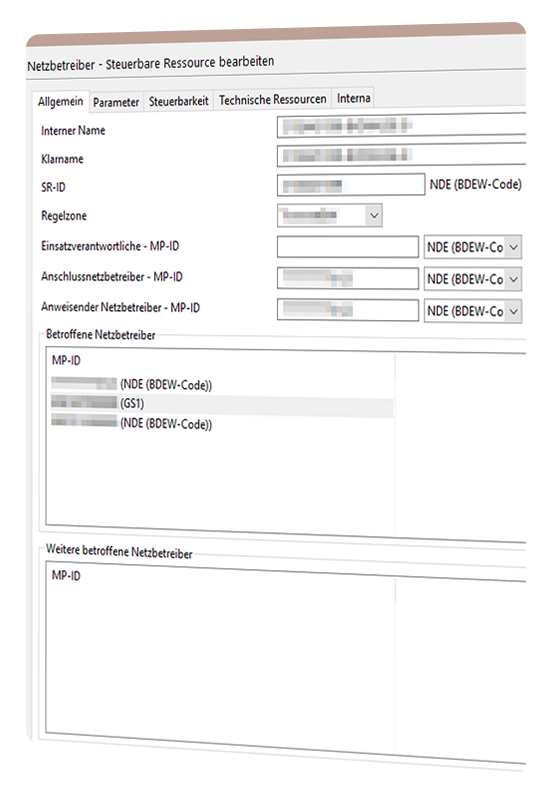SCADA

Optimise network control and avoid bottlenecks
Redispatch 2.0 - Better Overviews, Reliable Forecasts, Quick Response
Redispatch helps to secure the system stability of the power grid and belongs to the so-called market-related measures according to § 13.1. EnWG (German Energy Industry Act).
For the implementation of Redispatch 2.0, VIVAVIS AG offers the HIGH-LEIT Redispatch 2.0 system. As you can see in the figure below, Redispatch 2.0 supplements the HIGH-LEIT ADM system; it includes the necessary interface modules to connect the systems that are involved in the redispatch process. Add-on modules enable the implementation of tasks through Plant Operators (PO) as well as Operations Managers (OM). The scope of required modules depends on whether or not there is a risk of bottlenecks in the plant operator’s own power grid.
Features
Master Data Module
The Master Data Module is an integral part of the Redispatch module; it serves as a central database for all static data required by the redispatch process. In accordance with the master data structure prescribed by BNetzA (German Federal Network Agency), the Master Data Module includes the parameters required for data exchange for every technical resource (TR), every controllable resource (CR), every control group (CG) as well as for clustered resources (CR). In this context, we differentiate between initial, enriched, control group and cluster master data. A user-friendly environment enables the visualisation, modification and management of all master data.The Master Data Module not only enables manual data input, but also the import of data via EXCEL file.
Interfaces
Interface to the RAIDA data platform from connect+, for standardised data exchange in accordance with PVK and NKK processes (PVK = Mail Distribution Concept via Single Point of Contact ; NKK = Grid Coordination Concept), interface to energy production forecast and load import, respectively, interface to HIGH-LEIT for the exchange of commands, interface to EDM systems for the transmission of the determined loss of electricity production in the form of a CSV file.Data Exchange
The Redispatch 2.0 system is the central component for the execution of all redispatch processes, in accordance with the stipulations of the BNetzA (German Federal Network Agency):- Initial transmission of master data
- Transmission of enriched master data
- Modification of master data
- Transmission of planning data: Energy production forecasts/operation schedules, Redispatch potential, Sensitivities
- Notification of non-availability
- Market-specific adjustments
- Activation
- Transmission of data to determine the loss of electricity production in the EDM (Energy Data Management system)
- Determination of the loss of electricity production and transmission of these data to the EDM
These processes are executed largely automatically. A user-friendly environment enables users to view the status of individual processes and the data that are transferred in this context. The data that are exchanged in the course of theses processes are archived can can be retrieved as proof at any time.
Requests
The request information received via connect+ is managed by the Redispatch module; the corresponding commands are transmitted to the ADM system for execution at the requested time. These processes are controlled by the HIGH-LEIT ADM system.Power grid operators whose systems might be affected by bottlenecks need to eliminate them. For this purpose, the redispatch requirements are first determined and, secondly, the installations that are required to eliminate the bottlenecks are selected according to cost optimisation aspects.
Loss of Electricity Production
After a measure has been taken, the loss of energy production that has occurred during the execution of said measure (i.e. the delta between a forecast/operations schedule and the actual execution of the measure) needs to be determined and transmitted to the EDM system for billing purposes (Plant Operator and Operations Manager, respectively). This is done on the basis of measured values from the ADM system which map the actual characteristic and the forecast time series/operation schedules for each affected plant.This process works according to the following procedure, in accordance with the Plant Operator’s specifications: ex-post model, ex-post light model, flat rate model Transmission of this data to the EDM in the form of an AAÜZ (Ausfallarbeitsüberführungszeitreihe - loss of electricity production transfer time series) in CSV format.
Sensitivity Analysis and Dimensioning of Measures
This functionality is based on forecast-based grid calculation in the ADM system. This function is required in addition to on-line grid calculation if there is a possibility of bottlenecks in one’s own power grid. It serves for determining the time at which a bottleneck is likely to occur, as well as the corresponding redispatch requirements for the elimination of the bottleneck. Redispatch 2.0 determines the effects on bottlenecks for all controllable resources (CRs).For each CR, production costs and minimum legal aspects are taken into account. Based on these data, a dimensioning of measures is done in order to determine a the most cost-efficient group of CRs to be employed. For these CRs, the appropriate measures are planned, transmitted via connect+, and the corresponding requests are made.
Module for Operations Managers
For each system that might be eligible for redispatch, the Technical Resource Operator (TRO) has to appoint an Operations Manager (OM). For systems within the forecast model, the tasks of the OM (transmission of planning data) are partly taken over by the DNO (Distribution Network Operator). Power grid operators usually have their own systems which might be part of the planned value model but for which the grid operator has to assume the tasks of a regular Operations Manager (OM). This means that, apart from the transmission of enriched master and planning data, the grid operator has to fulfil the following additional tasks such as Transmission of initial master data, notification of non-availability and market-specific adjustmentsas well as submission of a cost sheet. Systems in the planned value model can be created separately in the master data module. Transmission of the data to the RAIDA platform takes place via mail distribution concept (single point of contact).



